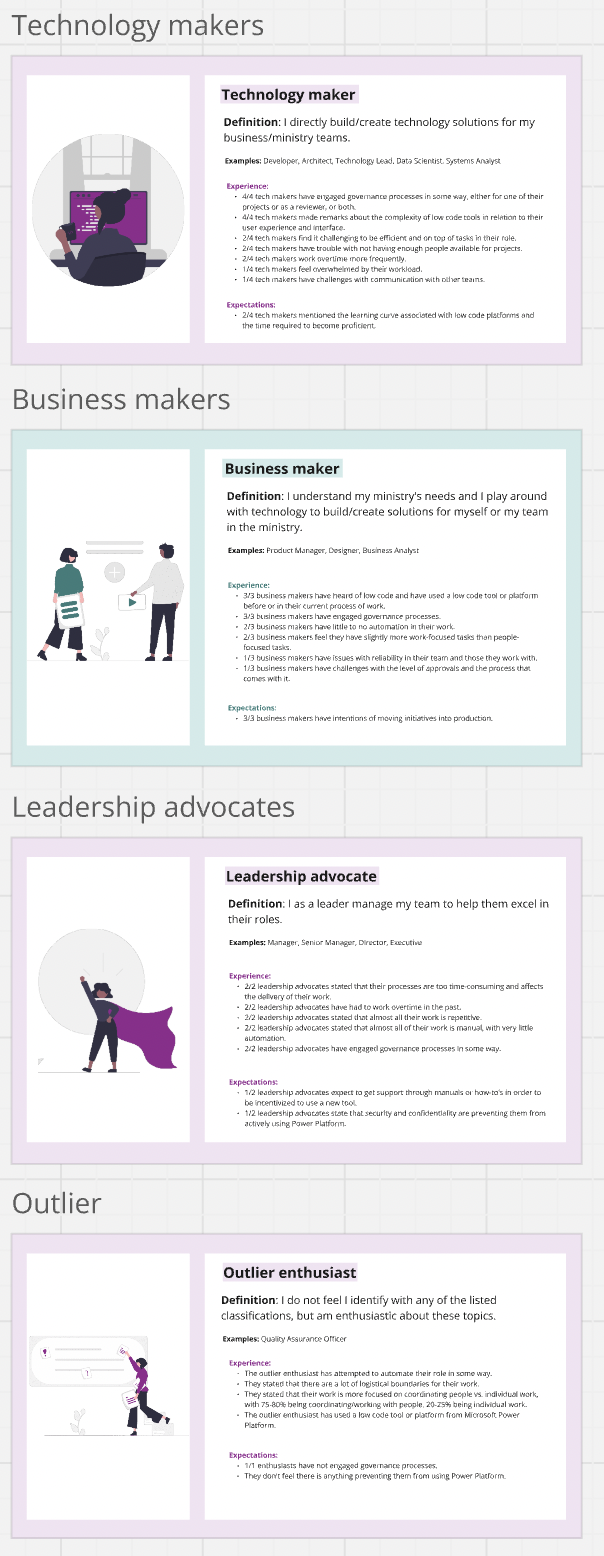AccelerateON
Making low code an enterprise-wide service for employees of the Ontario Government, Ontario Public Service.

Overview of the project
Role
User research, UI design, Affinity mapping, Client communications
*NOTE: This project is the responsibility of the Digital Solutions and Innovation Unit.
Project Duration
This project began in June 2023 and is ongoing.
Tools Used
Word, Excel, PowerPoint, Outlook, Miro, Figma, Illustrator, Power Platform
Discovery phase
In the summer of 2022, the Digital Solutions and Innovation Unit was tasked with exploring ways to integrate low code into the Ontario Public Service to make products and services simpler, better, and faster. We wanted to leverage the low code tools our own team had been using, such as Microsoft Power Apps and Power Automate, and provide employees access to these tools for their own use.
Design Goal
“How might we drive low code adoption to democratize IT (Information Technology), reduce shadow IT, reduce overtime, digitize and automate business processes, and increase the opportunity for innovation in the OPS?”
Mapping out the Vision and Goals
We met with our stakeholders alongside our internal team to determine our goals for the project, and what we hoped to achieve with a solution that made low code an enterprise-wide service.
Empathy and Opportunity Mapping
Based on our vision and goals, we mapped out our user groups to understand their needs, their pain points, and the opportunities for improvement.
Service Blueprints
Once we had a better understanding of our target user groups, we then created high-level service blueprints to understand the different layers of our service, and how users can request access to different facets of Microsoft Power Platform.
We had four main paths users may utilize when wanting to gain access to Power Platform tools and engage our team:
Licences
Environments
Low code consultations
Power Pages
Conducting Research
Once we had our preliminary artifacts completed, it was time to recruit for research. We did so by sending out screener surveys to employees using Viva Engage, a company communication platform asking those interested to participate in a research session.
Recruitment
We met with 22 users from across the OPS to understand their experiences with low code and governance processes.
5 out of 22 users had an existing Power Platform licence.
17 out of 22 users had little to no knowledge of low code or similar technology.
Findings
After completing our user interviews, we had 20 key themes based on users’ experience with low code, varying from pain points to opportunities for improvement.
Finalizing Personas
After completing our research, we were able to finalize our personas and understand each user group we spoke to. The Personas were created based on users’ experience with low code, their role in the OPS, and any other determining factors.
Alpha phase
After completing the Discovery phase of the project, it was time to move into more testing and further iterating for AccelerateON.
Card Sorting
We conducted open card sorting using the content used in our PDF documentation shared with clients. We provided cards with this content and asked users to sort the information based on what made most sense to them.
Tree Testing
After our card sort, we used the information from users to create a high-level prototype of our proposed navigation. This navigation was for our internal service portal that would serve as our one-stop-shop for clients to learn more about our services without needing to use lengthy PDF files.
Usability Testing
Once we had completed both card sorting and tree testing, we were able to redesign our internal service portal with the feedback from our users. We conducted rounds of usability testing on the service portal to ensure it was easy to navigate, contained simple and concise language, and assisted users in gaining all the relevant information for their request.
Beta phase (current phase)
Once Alpha was completed, the project moved into the Beta phase, where it currently resides before Live.
Exploring Communities of Practice
Once the internal service portal was completed and had been tested, we wanted to explore an area of the project that hadn’t yet been addressed: communities of practice.
User Research on OPS employee experience with Communities of Practice
We decided to run user research to learn of employees’ experience with communities of practice, either connected to the OPS or externally.
Conclusion and next steps
Reduced manual workload by 60%
We determined that the introduction of low code reduced OPS employees’ manual workload by around 60%.
Internal Service Portal
We created an internal service portal where clients could come and learn about Power Platform and what we offer. The service portal would act as a self-service option for clients to find the information they need and request licences to Power Platform.
Successful User Research
Our several rounds of user research produced helpful and insightful results for our team to use in future designs and improvements.





















